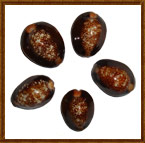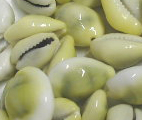|





| |
Diwaali>Chhoti
Diwali
Chhoti
Diwali - Naraka Chaturdasi
|
Chhoti Diwali is on October 18,
2017
|
When is Diwali in 2017|
Diwali Legend |Diwali - Five days Celebration |
Diwali Significance
|
|
Dhanteras
|
Chhoti
Diwali |
Diwali Pooja |
Govardhan Pooja |
Bhaiduj |
Laxmi Pooja |
Ganesh Pooja |
|
Diwali in
Sikhism |
Diwali in Jainism |
Special Significance of Diwali
|Diwali Pooja
Process |
|
New Products !
Rarest Pooja Products arrived :
|
|
Black Kaudi | Kaali Kowdi
 Black
Kaudi or Kaalili Kowdi or Black Cowrie shell is of great
significance in the worship of Goddess Maha Kaali ji and Lord
Bhairav ji. Black
Kaudi or Kaalili Kowdi or Black Cowrie shell is of great
significance in the worship of Goddess Maha Kaali ji and Lord
Bhairav ji.
It protect from negative
energies of black magic and relieves the native from the clutches of
tantra.In Astrology, Black Kaudi is used to balance the planetary
effect of Saturn and the malefic effects of Ketu and Rahu.It ensures
protection from spirits and blck magic.
...read more |
Yellow Kaudi | Peeli Kowdi
 Yellow Kaudi or Peeli Kowdi or Yellow Cowrie shell is of great
significance in the worship of Goddess Mahalaxmi and Lord Vishnu. Yellow Kaudi or Peeli Kowdi or Yellow Cowrie shell is of great
significance in the worship of Goddess Mahalaxmi and Lord Vishnu.
Yellow Kaudi is used to balance the planetary effect of
Jupiter and the malefic effects of Ketu and Rahu. When kept on Dhanteras and Akshay Triteeya, Yellow Kaudi ensures
a smooth flow of money.
...read more |
 The day before Diwali is celebrated as Chhoti
Diwali / Narak Chaturdasi or 'small Diwali'. It is Diwali on a smaller scale,
with fewer lights lit and fewer crackers burst. The morning after Choti Diwali,
the women of the house make beautiful, colored rangoli in the doorway and
courtyard. Tiny footprints made out of rice paste are a special feature of the
rangolis made for Diwali. In Hindu homes, Chhoti Diwali celebrations involve a
ritual puja to Goddess Lakshmi and also to Rama in the evening. Songs in honor
of the god are sung and aarti is performed. The day before Diwali is celebrated as Chhoti
Diwali / Narak Chaturdasi or 'small Diwali'. It is Diwali on a smaller scale,
with fewer lights lit and fewer crackers burst. The morning after Choti Diwali,
the women of the house make beautiful, colored rangoli in the doorway and
courtyard. Tiny footprints made out of rice paste are a special feature of the
rangolis made for Diwali. In Hindu homes, Chhoti Diwali celebrations involve a
ritual puja to Goddess Lakshmi and also to Rama in the evening. Songs in honor
of the god are sung and aarti is performed.
Legends behind Chhoti Diwali - Narak Charturdasi
The story goes that the demon king
Narakasura ruler of Pragjyotishpur (a province to the South of Nepal) after
defeating Lord Indra had snatched away the magnificent earrings of Aditi, the
Mother Goddess (the ruler of Suraloka and a relative of Satyabhama, Lord
Krishna's wife) and imprisoned sixteen thousand daughters of the gods and saints
in his harem.
On coming to know about this, Satyabhama was enraged by Narakasura's malevolence
towards women, and she appealed to Krishna to give her the golden chance to
destroy Narakasura. The legend also says that Narakasura was given a curse that
he would be killed by a woman. Krishna granted Satyabhama a boon to fight with
Narakasura. With Krishna as the charioteer, Satyabhama entered the battle field.
During the war, Krishna swooned for a while, a preordained divinely act adopted
to empower Satyabhama to kill the demon. After Narakasura was beheaded, the
imprisoned women were released, and Krishna accepted to marry them.
So on the day previous to Naraka-chaturdashi, Lord Krishna's divine intervention
led to the killing of the demon, Narakasura and liberation of the imprisoned
damsels as well as recovery of the precious earrings of Aditi. As a symbol of
that victory Lord Krishna smeared his forehead with the demon king's blood.
Krishna returned home in the very early morning of the Narakachaturdashi day.
The womenfolk massaged scented oil to his body and gave him a good bath to wash
away the filth from his body. Since then the custom of taking bath before
sunrise on this day has become a traditional practice specially in Maharashtra.
It is interesting to note that Bhudevi, mother of the slain Narakasura, declared
that his death should not be a day of mourning but an occasion to celebrate and
rejoice. Since then, Deepavali is being celebrated by people every year with
joyous celebrations with lot of fun and frolic, and fire works.
In South India that victory of the divine over the mundane is celebrated in a
very peculiar way. People wake up before sunrise prepare a paste by mixing
Kumkum in oil, symbolizing blood and after breaking a bitter fruit that
represents the head of the demon King that was smashed by Krishna, apply that
mixture on their foreheads. Then they have an oil bath using sandalwood paste.
In Maharashtra also, traditional early baths with oil and "Uptan" (paste) of
gram flour and fragrant powders are a `must'. All through the ritual of baths,
deafening sounds of crackers and fireworks are there in order that the children
enjoy bathing. Afterward steamed vermicelli with milk and sugar or puffed rice
with curd is served.
 Top Top
| |



|
![]() 0091 - 9839117339 , 0091 -
9336344500 (24 x 7 Availability)
0091 - 9839117339 , 0091 -
9336344500 (24 x 7 Availability) ![]() astro_jyotishi@yahoo.com
astro_jyotishi@yahoo.com
